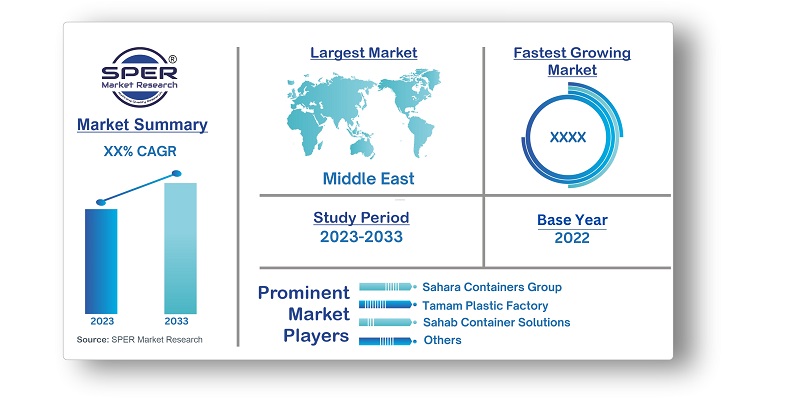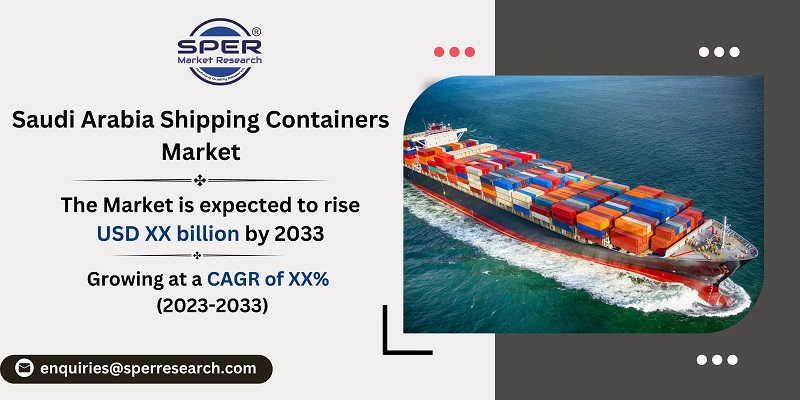
Saudi Arabia Shipping Containers Market Growth, Size, Trends, Revenue, Share and Future Outlook
Saudi Arabia Shipping Containers Market Size– By Container Size, By Product Type, By End User- Regional Outlook, Competitive Strategies and Segment Forecast to 2033
| Published: Aug-2023 | Report ID: PACK2322 | Pages: 1 - 109 | Formats*: |
| Category : Packaging | |||
- Foreign Trade Expansion: As Saudi Arabia's economy continues to develop and diversify, foreign trade is becoming increasingly important. The number of imports and exports directly affects the demand for shipping containers. The country's initiatives to promote non-oil sectors and enhance exports may result in a greater demand for containers to expedite the movement of products.
- Infrastructure Development: Investments in marine infrastructure, such as the growth of ports, container terminals, and logistical facilities, can enhance the shipping container market. Modernized infrastructure allows more efficient container handling and activity, attracting shipping corporations and traders to use Saudi Arabian ports.


| Report Metric | Details |
| Market size available for years | 2019-2033 |
| Base year considered | 2022 |
| Forecast period | 2023-2033 |
| Segments covered | By Container Size, By Product Type, By End User |
| Regions covered | Northern Region, Southern Region, Eastern Region, Western Region |
| Companies Covered | Sahara Containers Group, Tamam Plastic Factory, Sahab Container Solutions, MAFCO, Arabian Bemco Contracting Co. Ltd., Almar Container Group, Olayan Financing Company, Others |
- Shipping Companies and Lines
- Logistics and Freight Forwarding Companies
- Port Authorities and Terminal Operators
- Manufacturers and Exporters
- Importers and Distributors
| By Container Size: |
|
| By Product Type: |
|
| By End User: |
|
- Saudi Arabia Shipping Containers Market Size (FY’2023-FY’2033)
- Overview of Saudi Arabia Shipping Containers Market
- Segmentation of Saudi Arabia Shipping Containers Market By Container Size (High Cube Container, Large Container, Small Container)
- Segmentation of Saudi Arabia Shipping Containers Market By Product Type (Dry Storage Container, Flat Rack Container, Refrigerated Container, Others)
- Segmentation of Saudi Arabia Shipping Containers Market By End User (Consumer Goods, Food & Beverages, Healthcare, Industrial Products, Others)
- Statistical Snap of Saudi Arabia Shipping Containers Market
- Expansion Analysis of Saudi Arabia Shipping Containers Market
- Problems and Obstacles in Saudi Arabia Shipping Containers Market
- Competitive Landscape in the Saudi Arabia Shipping Containers Market
- Impact of COVID-19 and Demonetization on Saudi Arabia Shipping Containers Market
- Details on Current Investment in Saudi Arabia Shipping Containers Market
- Competitive Analysis of Saudi Arabia Shipping Containers Market
- Prominent Players in the Saudi Arabia Shipping Containers Market
- SWOT Analysis of Saudi Arabia Shipping Containers Market
- Saudi Arabia Shipping Containers Market Future Outlook and Projections (FY’2023-FY’2033)
- Recommendations from Analyst
1.1. Scope of the report1.2. Market segment analysis
2.1. Research data source2.1.1. Secondary Data2.1.2. Primary Data2.1.3. SPER’s internal database2.1.4. Premium insight from KOL’s2.2. Market size estimation2.2.1. Top-down and Bottom-up approach2.3. Data triangulation
4.1. Driver, Restraint, Opportunity and Challenges analysis4.1.1. Drivers4.1.2. Restraints4.1.3. Opportunities4.1.4. Challenges4.2. COVID-19 Impacts of the Saudi Arabia Shipping Containers Market
5.1. SWOT Analysis5.1.1. Strengths5.1.2. Weaknesses5.1.3. Opportunities5.1.4. Threats5.2. PESTEL Analysis5.2.1. Political Landscape5.2.2. Economic Landscape5.2.3. Social Landscape5.2.4. Technological Landscape5.2.5. Environmental Landscape5.2.6. Legal Landscape5.3. PORTER’s Five Forces5.3.1. Bargaining power of suppliers5.3.2. Bargaining power of buyers5.3.3. Threat of Substitute5.3.4. Threat of new entrant5.3.5. Competitive rivalry5.4. Heat Map Analysis
6.1. Saudi Arabia Shipping Containers Market Manufacturing Base Distribution, Sales Area, Product Type6.2. Mergers & Acquisitions, Partnerships, Product Launch, and Collaboration in Saudi Arabia Shipping Containers Market
7.1. Saudi Arabia Shipping Containers Market Value Share and Forecast, By Container Size, 2023-20337.2. High Cube Container7.3. Large Container7.4. Small Container
8.1. Saudi Arabia Shipping Containers Market Value Share and Forecast, By Product Type, 2023-20338.2. Dry Storage Container8.3. Flat Rack Container8.4. Refrigerated Container8.5. Others
9.1. Saudi Arabia Shipping Containers Market Value Share and Forecast, By End User, 2023-20339.2. Consumer Goods9.3. Food & Beverages9.4. Healthcare9.5. Industrial Products9.6. Others
10.1. Saudi Arabia Shipping Containers Market Size and Market Share
11.1. Saudi Arabia Shipping Containers Market Size and Market Share by Container Size (2019-2026)11.2. Saudi Arabia Shipping Containers Market Size and Market Share by Container Size (2027-2033)
12.1. Saudi Arabia Shipping Containers Market Size and Market Share by Product Type (2019-2026)12.2. Saudi Arabia Shipping Containers Market Size and Market Share by Product Type (2027-2033)
13.1. Saudi Arabia Shipping Containers Market Size and Market Share by End User (2019-2026)13.2. Saudi Arabia Shipping Containers Market Size and Market Share by End User (2027-2033)
14.1. Saudi Arabia Shipping Containers Market Size and Market Share by Region (2019-2026)14.2. Saudi Arabia Shipping Containers Market Size and Market Share by Region (2027-2033)14.3. Northern Region14.4. Southern Region14.5. Eastern Region14.6. Western Region
15.1. Sahara Containers Group15.1.1. Company details15.1.2. Financial outlook15.1.3. Product summary15.1.4. Recent developments15.2. Tamam Plastic Factory15.2.1. Company details15.2.2. Financial outlook15.2.3. Product summary15.2.4. Recent developments15.3. Sahab Container Solutions15.3.1. Company details15.3.2. Financial outlook15.3.3. Product summary15.3.4. Recent developments15.4. MAFCO15.4.1. Company details15.4.2. Financial outlook15.4.3. Product summary15.4.4. Recent developments15.5. Arabian Bemco Contracting Co. Ltd.15.5.1. Company details15.5.2. Financial outlook15.5.3. Product summary15.5.4. Recent developments15.6. Almar Container Group15.6.1. Company details15.6.2. Financial outlook15.6.3. Product summary15.6.4. Recent developments15.7. Olayan Financing Company15.7.1. Company details15.7.2. Financial outlook15.7.3. Product summary15.7.4. Recent developments15.8. Others
SPER Market Research’s methodology uses great emphasis on primary research to ensure that the market intelligence insights are up to date, reliable and accurate. Primary interviews are done with players involved in each phase of a supply chain to analyze the market forecasting. The secondary research method is used to help you fully understand how the future markets and the spending patterns look likes.
The report is based on in-depth qualitative and quantitative analysis of the Product Market. The quantitative analysis involves the application of various projection and sampling techniques. The qualitative analysis involves primary interviews, surveys, and vendor briefings. The data gathered as a result of these processes are validated through experts opinion. Our research methodology entails an ideal mixture of primary and secondary initiatives.



Frequently Asked Questions About This Report
PLACE AN ORDER
Year End Discount
Sample Report
Pre-Purchase Inquiry
NEED CUSTOMIZATION?
Request CustomizationCALL OR EMAIL US
100% Secure Payment






Related Reports
Our Global Clients
Our data-driven insights have influenced the strategy of 200+ reputed companies across the globe.




















